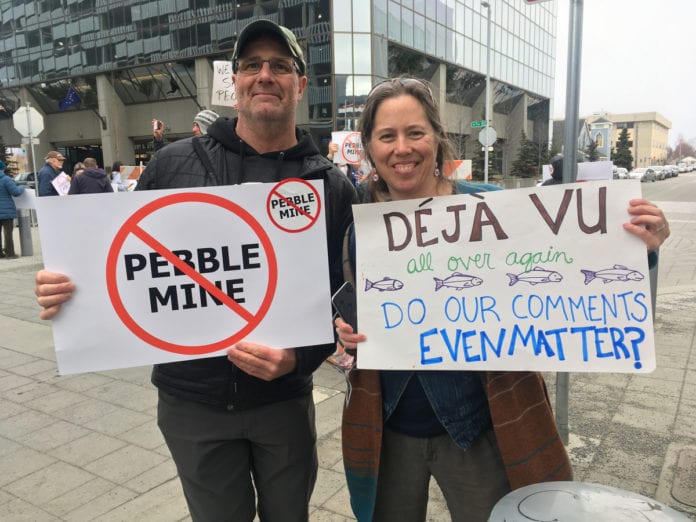
By Pam Miller
In a recent story about the Pebble Mine, Alaskan officials called attention to “Alaska’s robust environmental laws.” In November, former state Senator Drue Pearce praised Alaska’s “world-class environmental practices” in an op-ed on energy policy. These false claims perpetuate myths of environmental excellence when in fact Alaska has some of the worst pollution and an appalling lack of environmental oversight and compliance.
Let’s start by looking into the state of Alaska’s recent failure to address highly toxic PFAS (per- and polyfluoroalkyl substances). In August, Governor Mike Dunleavy vetoed House Bill 51, a bill that would have been a significant step toward preventing further harm to public health from these dangerous chemicals. The bill had been passed with bi-partisan support and with near unanimity by the legislature in May. Currently, there are 469 sites in Alaska where PFAS contamination has been identified in soil and water, according to the Alaska Department of Environmental Conservation (ADEC), including contamination of drinking water sources in communities throughout Alaska.
Alaska is damaged by 6,000 contaminated sites caused by extractive industries and military operations, the majority not responsibly remediated due to the failure of the ADEC to hold the polluters accountable. Our state also has the dubious distinction of having the highest releases of toxic chemicals to air, water, and land according to the Environmental Protection Agency’s (EPA) annual Toxics Release Inventory—a total of 777,097,059 pounds according to the most recent available data from 2022. Metal mining is the leading source of toxic releases in Alaska.
Of the five major operating mines in Alaska, including Red Dog, Fort Knox, Pogo, Kensington, and Greens Creek, all have experienced at least one major spill or other accidental release of hazardous materials such as mine tailings, cyanide solution, diesel fuel, and ore concentrate. Four of the five mines failed to capture or control contaminated mine water, resulting in water quality violations that often occurred over an extended period. Four of the five mines have been identified by the EPA as out of compliance with federal laws to protect clean air or water in the last three years. The Environmental Impact Statement (EIS) process at four of the mines underestimated water quality impacts, failing to predict violations of federal and state laws. Metals pollution from two of the mines has contaminated public lands designated as National Monuments (Greens Creek and Red Dog).
A 2022 report found “more than 8,150 total spills associated with these five mines between 1995 and 2020, or approximately three hundred spills each year. These mining operation spills released more than 2.3 million gallons and 1.9 million pounds of hazardous materials during that 26-year span.”
As an example of lax regulation and oversight of the oil and gas industry in Alaska, a special exemption allows the industry in Cook Inlet to dump up to two billion gallons of toxic waste each year, the only such exemption for oil and gas facilities in the nation. In 2017, a Hilcorp Energy Company underwater gas pipeline leaked for over three months, releasing about 200,000 cubic feet of almost pure methane into Cook Inlet, and gas leaks occurred again from the same pipeline in 2019 and 2021. In late February and March 2022, 7.2 million cubic feet of natural gas leaked from multiple wellheads in the Conoco Phillips Alpine oilfield located close to Nuiqsut, forcing evacuation of about 300 personnel and a shutdown. No provisions were made to evacuate residents of Nuiqsut.
Considering the magnitude and harm associated with the Exxon Valdez oil spill of 1989, one would think Alaska would be doing all it could to avoid another incident related to the shipping of oil. However, according to a March 2023 report of the Prince William Sound Regional Citizen’s Advisory Council, a federally established watchdog group, “there currently is an unacceptable safety risk to the Valdez Marine Terminal (VMT), and consequently no reasonable assurance that the VMT is operating safely and in compliance with its regulatory requirements.”
Kate Troll and Hollis French point out that “Alaska remains a loner among states – no coastal management program and no climate action plan. This is a far cry from having environmental standards considered to be some of the highest in the world.”
It’s high time for state officials to stop misrepresenting the facts in order to justify more harmful mining and oil and gas extraction.
Pamela Miller is executive director and senior scientist for Alaska Community Action on Toxics. She also serves as a principal scientific investigator for research projects supported by the National Institute of Environmental Health Sciences about the effects of endocrine-disrupting chemicals on the environment and people.














